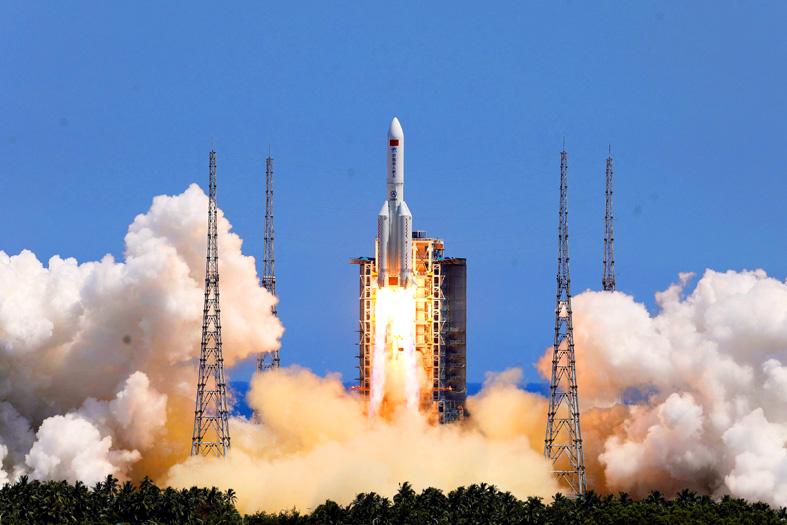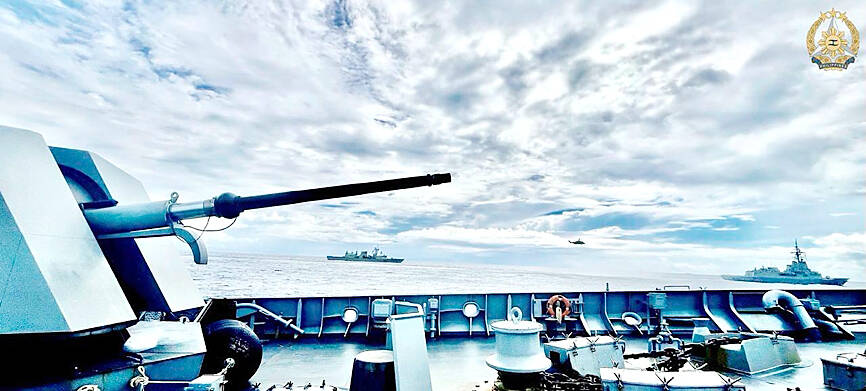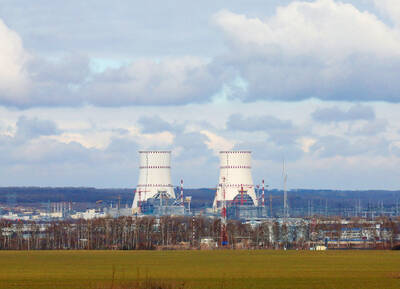China yesterday launched the second of three modules required to complete its new space station, state media reported, the latest step in Beijing’s ambitious space program.
The uncrewed craft, named Wentian, was propelled by a Long March 5B rocket at 2:22pm from the Wenchang launch site on the island of Hainan.
Beijing in April last year launched the central module of its space station Tiangong, which means “heavenly palace.”

Photo: Reuters
Almost 18m long and weighing 22 tonnes, the new module has three sleeping areas and a laboratory for scientific experiments.
It will dock with the existing module in space, a challenging operation that experts said would require several high-precision manipulations and use of a robotic arm.
“This is the first time China has docked such large vehicles together, which is a delicate operation,” said Jonathan McDowell, an astronomer at the Harvard-Smithsonian Center for Astrophysics.
He said until the next module arrives, the space station will have a “rather unusual L-shape,” which requires a substantial amount of power to keep stable.
“These are all technical challenges that the USSR pioneered with the Mir station in the late 1980s, but it’s new to China,” he said. “But it will result in a much more capable station, with the space and power to carry out more scientific experiments.”
Wentian will also serve as a backup platform to control the space station in the event of a failure. The third and final module is scheduled to dock in October, and Tiangong — which should have a lifespan of at least 10 years — is expected to become fully operational by the end of the year.
Under Chinese President Xi Jinping (習近平), the country’s plans for its heavily promoted “space dream” have been put into overdrive.
China has made large strides in catching up with the US and Russia, where astronauts and cosmonauts have decades of experience in space exploration.
The Chinese space station will be completed in 18 months, the fastest in history for a modular space station, space technology analyst Chen Lan (陳藍) said, adding that Mir and the International Space Station (ISS) took 10 and 12 years respectively.
China’s space program has already landed a rover on Mars and sent probes to the moon.
In addition to a space station, Beijing is planning to build a base on the moon and send humans there by 2030.
China has been excluded from the International Space Station since 2011, when the US banned NASA from engaging with the country.
While China does not plan to use its space station for global cooperation on the scale of the ISS, Beijing has said it is open to foreign collaboration.

Philippine President Ferdinand Marcos Jr has fired his national police chief, who gained attention for leading the separate arrests of former Philippine president Rodrigo Duterte on orders of the International Criminal Court and televangelist Apollo Carreon Quiboloy, who is on the FBI’s most-wanted list for alleged child sex trafficking. Philippine Executive Secretary Lucas Bersamin did not cite a reason for the removal of General Nicolas Torre as head of the 232,000-member national police force, a position he was appointed to by Marcos in May and which he would have held until 2027. He was replaced by another senior police general, Jose

STILL AFLOAT: Satellite images show that a Chinese ship damaged in a collision earlier this month was under repair on Hainan, but Beijing has not commented on the incident Australia, Canada and the Philippines on Wednesday deployed three warships and aircraft for drills against simulated aerial threats off a disputed South China Sea shoal where Chinese forces have used risky maneuvers to try to drive away Manila’s aircraft and ships. The Philippine military said the naval drills east of Scarborough Shoal (Huangyan Island, 黃岩島) were concluded safely, and it did not mention any encounter with China’s coast guard, navy or suspected militia ships, which have been closely guarding the uninhabited fishing atoll off northwestern Philippines for years. Chinese officials did not immediately issue any comment on the naval drills, but they

POWER CONFLICT: The US president threatened to deploy National Guards in Baltimore. US media reports said he is also planning to station troops in Chicago US President Donald Trump on Sunday threatened to deploy National Guard troops to yet another Democratic stronghold, the Maryland city of Baltimore, as he seeks to expand his crackdown on crime and immigration. The Republican’s latest online rant about an “out of control, crime-ridden” city comes as Democratic state leaders — including Maryland Governor Wes Moore — line up to berate Trump on a high-profile political stage. Trump this month deployed the National Guard to the streets of Washington, in a widely criticized show of force the president said amounts to a federal takeover of US capital policing. The Guard began carrying

Ukrainian drone attacks overnight on several Russian power and energy facilities forced capacity reduction at the Kursk Nuclear Power Plant and set a fuel export terminal in Ust-Luga on fire, Russian officials said yesterday. A drone attack on the Kursk nuclear plant, not far from the border with Ukraine, damaged an auxiliary transformer and led to 50 percent reduction in the operating capacity at unit three of the plant, the plant’s press service said. There were no injuries and a fire sparked by the attack was promptly extinguished, the plant said. Radiation levels at the site and in the surrounding